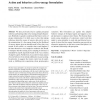396 search results - page 53 / 80 » How scientific models can explain |
CHI
2009
ACM
2009
ACM
Social immersive media: pursuing best practices for multi-user interactive camera/projector exhibits
14 years 8 months ago
Based on ten years' experience developing interactive camera/projector systems for public science and culture exhibits, we define a distinct form of augmented reality focused...
HOTOS
2007
IEEE
13 years 11 months ago
2007
IEEE
We propose a new concurrent programming model, Automatic Mutual Exclusion (AME). In contrast to lock-based programming, and to other programming models built over software transac...
IEEESP
2010
13 years 6 months ago
2010
Abstract. We devise a model for security investment that reflects dynamic interaction between a defender, who faces uncertainty, and an attacker, who repeatedly targets the weakes...
MANSCI
2006
13 years 7 months ago
2006
In many different managerial contexts, consumers "leave money on the table" by, for example, their failure to claim rebates, use available coupons, and so on. This proje...
BC
2010
13 years 5 months ago
2010
We have previously tried to explain perceptual inference and learning under a free-energy principle that pursues Helmholtz's agenda to understand the brain in terms of energy ...

